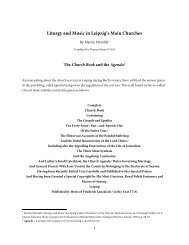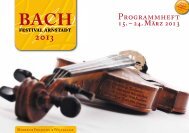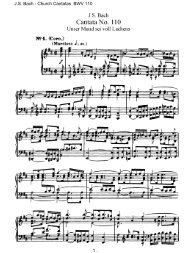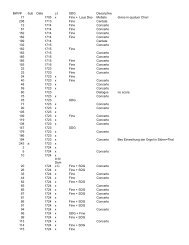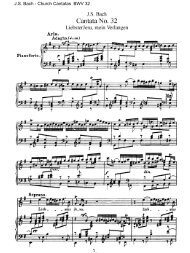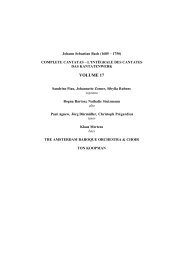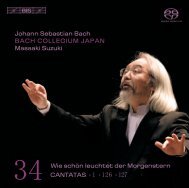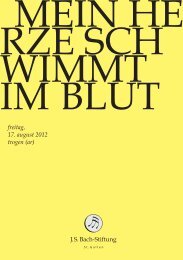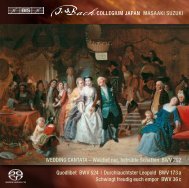Bach Cantatas, Vol. 2 - F. Werner (Erato 10-CD)
Bach Cantatas, Vol. 2 - F. Werner (Erato 10-CD)
Bach Cantatas, Vol. 2 - F. Werner (Erato 10-CD)
Create successful ePaper yourself
Turn your PDF publications into a flip-book with our unique Google optimized e-Paper software.
Herr, gehe nicht ins Gericht, BWV <strong>10</strong>5 dates from the first Leipzigrycle and was sung on the Ninth<br />
Sunday after Trinity (25 luly 1723); it is the tenth of the Leipzig cantatas chronologically. The<br />
Gospel for the day is the parable of the unjust steward (Luke 16: l-9); an unknown poet has turned<br />
it into an affirmation that |esus is the guardian who will save the soul of the faithful Christian and<br />
against whom the vain world and the Mammon of unrighteousness cannot prevail. This text, which<br />
nowadays appears, if an1'thing, a little dry, inspired <strong>Bach</strong> to one of his greatest feats of interpretation,<br />
mainly because he depicted the negative aspects, the sinfulness and guilt of Man, in continually<br />
changing pictures which may even be discerned in the second, more positive, half of the cantata. The<br />
opening chorus is modelled on the form of a prelude and fugue. The prelude is an Adagio in which<br />
the presentation of the text is intensified by exaggerated sighing motifs and suspended dissonances<br />
in the instrumental parts; in the Allegro fugue, the tempo and shape of the subject depict the living,<br />
whereas the descending countersubject and chromaticism exemplifr the text ("for in thy sight shall<br />
no man living be justified" -<br />
Psalm 143). Although the two arias are designed to contrast with one<br />
another, their keys (E flat and B flat) not only provide a link but also serve to differentiate them fiom<br />
the outer movements, which are in G minor. Man's wickedness is represented on several levels, both<br />
in the opening chorus and in the aria in E flat: the violins depict trembling and faltering, the oboe<br />
and voice parts writhe in sighing figures and broken seventh chords and engage in brief canons<br />
("Each one is the fault of the other bewailing"). The instability of Man's estate is symbolised by the<br />
most amazing feature of the whole movement: there is no bass line. The text "How happy is he who<br />
is firm assured" is perfectly captured by the recitativo accompagnato; the pizzicato basses represent<br />
the funeral bell which tolls until the last bar ("God will open wide the Gate of Heaven"), an idea<br />
which is all the more moving because of its very simplicity. The second aria appears to offer some<br />
light relief, but here again the music is conceived on several levels: the vocal part, the strings and the<br />
horn part, which occasionally resembles an ornamented chorale tune, symbolise the protection<br />
afforded by Iesus, the friend of the faithful. Scintillating violin figures depict "Mammon". Finally,<br />
the chorale in G minor also takes unusual account of the words themselves: above the four-part<br />
setting with its very varied harmonies the strings paint a sound-picture of the "conscience that is<br />
troubling me", which gradually calms down. The chromatic phrase of the first violin, a two-bar<br />
epilogue spanning a fourth, is like an anxious echo of the last line ("Life eternal we will gain").<br />
+)



